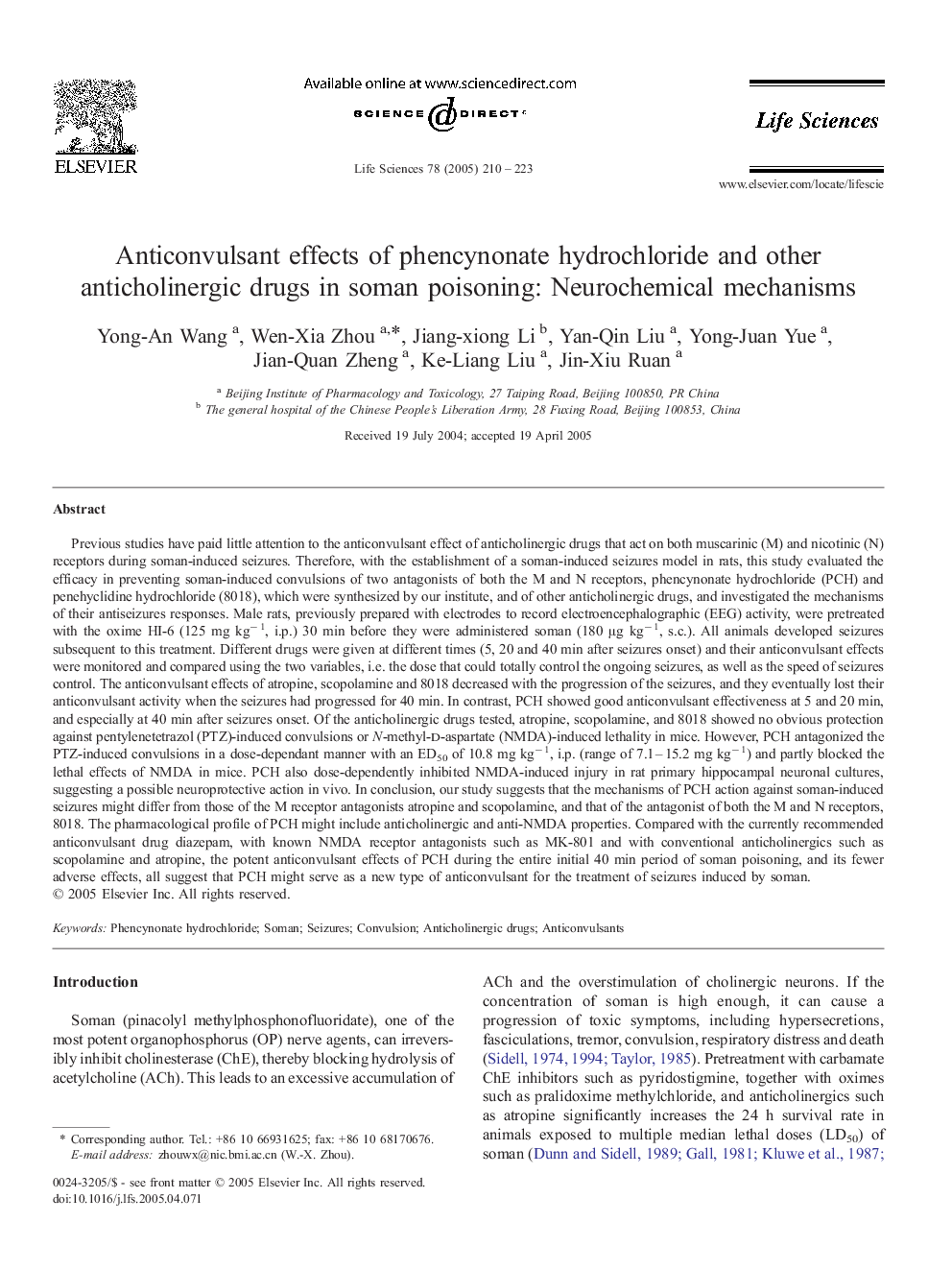| کد مقاله | کد نشریه | سال انتشار | مقاله انگلیسی | نسخه تمام متن |
|---|---|---|---|---|
| 9012659 | 1124995 | 2005 | 14 صفحه PDF | دانلود رایگان |
عنوان انگلیسی مقاله ISI
Anticonvulsant effects of phencynonate hydrochloride and other anticholinergic drugs in soman poisoning: Neurochemical mechanisms
دانلود مقاله + سفارش ترجمه
دانلود مقاله ISI انگلیسی
رایگان برای ایرانیان
کلمات کلیدی
موضوعات مرتبط
علوم پزشکی و سلامت
پزشکی و دندانپزشکی
کاردیولوژی و پزشکی قلب و عروق
پیش نمایش صفحه اول مقاله

چکیده انگلیسی
Previous studies have paid little attention to the anticonvulsant effect of anticholinergic drugs that act on both muscarinic (M) and nicotinic (N) receptors during soman-induced seizures. Therefore, with the establishment of a soman-induced seizures model in rats, this study evaluated the efficacy in preventing soman-induced convulsions of two antagonists of both the M and N receptors, phencynonate hydrochloride (PCH) and penehyclidine hydrochloride (8018), which were synthesized by our institute, and of other anticholinergic drugs, and investigated the mechanisms of their antiseizures responses. Male rats, previously prepared with electrodes to record electroencephalographic (EEG) activity, were pretreated with the oxime HI-6 (125 mg kgâ 1, i.p.) 30 min before they were administered soman (180 μg kgâ 1, s.c.). All animals developed seizures subsequent to this treatment. Different drugs were given at different times (5, 20 and 40 min after seizures onset) and their anticonvulsant effects were monitored and compared using the two variables, i.e. the dose that could totally control the ongoing seizures, as well as the speed of seizures control. The anticonvulsant effects of atropine, scopolamine and 8018 decreased with the progression of the seizures, and they eventually lost their anticonvulsant activity when the seizures had progressed for 40 min. In contrast, PCH showed good anticonvulsant effectiveness at 5 and 20 min, and especially at 40 min after seizures onset. Of the anticholinergic drugs tested, atropine, scopolamine, and 8018 showed no obvious protection against pentylenetetrazol (PTZ)-induced convulsions or N-methyl-d-aspartate (NMDA)-induced lethality in mice. However, PCH antagonized the PTZ-induced convulsions in a dose-dependant manner with an ED50 of 10.8 mg kgâ 1, i.p. (range of 7.1-15.2 mg kgâ 1) and partly blocked the lethal effects of NMDA in mice. PCH also dose-dependently inhibited NMDA-induced injury in rat primary hippocampal neuronal cultures, suggesting a possible neuroprotective action in vivo. In conclusion, our study suggests that the mechanisms of PCH action against soman-induced seizures might differ from those of the M receptor antagonists atropine and scopolamine, and that of the antagonist of both the M and N receptors, 8018. The pharmacological profile of PCH might include anticholinergic and anti-NMDA properties. Compared with the currently recommended anticonvulsant drug diazepam, with known NMDA receptor antagonists such as MK-801 and with conventional anticholinergics such as scopolamine and atropine, the potent anticonvulsant effects of PCH during the entire initial 40 min period of soman poisoning, and its fewer adverse effects, all suggest that PCH might serve as a new type of anticonvulsant for the treatment of seizures induced by soman.
ناشر
Database: Elsevier - ScienceDirect (ساینس دایرکت)
Journal: Life Sciences - Volume 78, Issue 2, 26 November 2005, Pages 210-223
Journal: Life Sciences - Volume 78, Issue 2, 26 November 2005, Pages 210-223
نویسندگان
Yong-An Wang, Wen-Xia Zhou, Jiang-xiong Li, Yan-Qin Liu, Yong-Juan Yue, Jian-Quan Zheng, Ke-Liang Liu, Jin-Xiu Ruan,